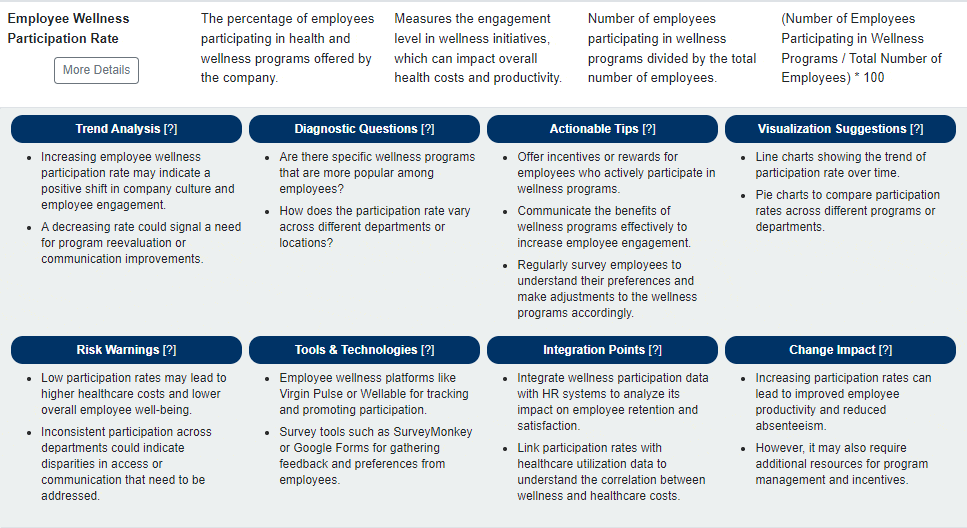Editor's Note: Take a look at our featured best practice, Cost Segregation Study: Multiple Property Class Analysis (Excel workbook). Accountants, accounting firms, and real estate property owners can all benefit from this cost segregation study (CSS) template. It makes the estimated benefit easy to figure out and has flexible assumptions for high level or detailed segregation analysis. You get a summary of cost [read more]
KPI Management: Health and Wellness KPIs
* * * *

This article explores the critical role of Health and Wellness programs within the framework of strategic planning and performance measurement, highlighting their growing importance in fostering a resilient and thriving workforce.
The aim of this article is to highlight the significance of implementing and measuring the effectiveness of Health and Wellness initiatives within organizations. By examining Key Performance Indicators (KPIs) associated with Health and Wellness, we intend to provide insights into how these metrics can guide decision-making, facilitate the formulation of robust strategies, and drive operational enhancements to support employee well-being.
Through this exploration, executives and senior managers will gain actionable strategies for enhancing workplace health and wellness programs, thereby contributing to higher employee engagement and organizational success.
Importance of Health & Wellness in the Workplace
The importance of Health and Wellness in the workplace has been magnified by the challenges of the modern work environment, including the rise of remote work and the increasing recognition of mental health’s impact on overall health.
Effective Health and Wellness programs are essential for mitigating the effects of workplace stress, preventing burnout, and promoting work-life balance. Such initiatives not only contribute to a healthier workforce but also enhance organizational performance by reducing absenteeism, lowering healthcare costs, and improving employee retention.
Challenges to Implementing Health & Wellness Programs
Organizations face several challenges in implementing effective Health and Wellness programs, including addressing diverse employee needs, measuring program impact, and ensuring participation. Additionally, the stigma surrounding mental health and the logistical complexities of supporting a remote or hybrid workforce present further obstacles.
KPIs within the Health and Wellness functional group address these challenges by offering a framework for evaluating program effectiveness, identifying areas for improvement, and tracking progress towards health and wellness objectives. By prioritizing Health and Wellness, companies can navigate these complexities, fostering an environment that supports employee well-being and drives long-term organizational growth.
Top 10 KPIs in Health & Wellness
We’ve identified the top 10 KPIs that drive Health and Wellness in the workplace. By focusing on these KPIs, organizations can effectively monitor and enhance their Health and Wellness programs, ensuring they meet employee needs, improve health outcomes, and contribute to organizational success. These KPIs are selected from the Flevy KPI Library, a robust database of over 15,000+ KPIs.
1. Employee Wellness Participation Rate
- Definition: Measures the percentage of employees actively participating in wellness programs offered by the organization.
- Relevance: Indicates employee engagement with wellness initiatives and the perceived value of these programs.
2. Employee Assistance Program (EAP) Utilization Rate
- Definition: The rate at which employees use EAP services, including counseling and mental health support.
- Relevance: Reflects the accessibility and effectiveness of support for employees’ mental and emotional well-being.
3. Health Risk Assessment Completion Rate
- Definition: The percentage of employees completing health risk assessments to identify potential health issues.
- Relevance: Essential for early detection and management of health risks, contributing to overall workforce health.
4. Employee Satisfaction Index with Health and Wellness Programs
- Definition: Measures employees’ satisfaction levels with the health and wellness programs provided.
- Relevance: A high satisfaction index can lead to increased participation rates and overall program effectiveness.
5. Absenteeism Rate
- Definition: The rate at which employees are absent from work for reasons related to health.
- Relevance: High absenteeism can indicate underlying health issues that wellness programs may need to address.
6. Healthcare Cost Per Employee
- Definition: The average cost incurred by the organization for employee healthcare benefits.
- Relevance: Helps organizations assess the financial impact of health-related expenses and the potential savings from effective wellness programs.
7. Employee Burnout Rate
- Definition: The percentage of employees experiencing burnout due to work-related stress.
- Relevance: Critical for identifying the need for stress management and mental health support within wellness programs.
8. Return on Investment (ROI) of Wellness Programs
- Definition: The financial return on the organization’s investment in wellness programs.
- Relevance: Demonstrates the financial viability and impact of wellness initiatives on reducing healthcare costs and improving productivity.
9. Stress Management Program Effectiveness
- Definition: Evaluates the success of programs aimed at reducing work-related stress among employees.
- Relevance: Effective stress management is crucial for maintaining mental health and productivity.
10. Work-Life Balance Programs
- Definition: Measures the availability and effectiveness of programs designed to help employees balance work demands with personal life.
- Relevance: Work-life balance is increasingly important for employee well-being and retention, particularly in remote and hybrid work environments.
To dig deeper into any of these KPIs, we invite you to explore the Flevy KPI Library, which allows you to drill down into 12 attributes for each KPI in the database. Here is an example for our top ranked KPI, Employee Wellness Participation Rate:
If you are interested in KPIs specific to Health Programs, take a look here. KPIs for Health and Wellness primarily focus on broad, organization-wide initiatives aimed at improving the overall well-being of employees, encompassing physical, mental, and emotional health. These KPIs measure engagement, satisfaction, and participation rates in wellness programs, the cultural aspects of health within the organization, and the impact of wellness initiatives on employee performance and organizational costs.
On the other hand, KPIs for Health Programs tend to be more specific and are often tied to targeted health interventions or services provided by the organization, such as EAP utilization rates, health risk assessments, or specific health outcomes related to chronic disease management. These KPIs assess the effectiveness, utilization, and outcomes of these individual health programs, focusing on direct health impacts and program-specific metrics.
Case Studies and Success Stories
Maximizing Employee Engagement through Wellness Participation
A leading retail company noticed declining “Employee Wellness Participation Rates” amidst growing concerns over employee health and productivity. The organization recognized the need to revitalize its wellness programs to boost engagement and overall employee well-being.
The company redesigned its wellness programs to include a wider range of activities, from mental health workshops to physical fitness challenges, and leveraged internal communications to raise awareness and encourage participation. The “Employee Wellness Participation Rate” served as a primary KPI to measure the success of these initiatives.
Outcome: The revamped programs led to a significant increase in wellness participation rates, which in turn, positively impacted the “Employee Satisfaction Index” with Health and Wellness Programs and reduced the “Absenteeism Rate.” Employees reported feeling more supported and engaged at work, highlighting the value of comprehensive and accessible wellness programs.
Lessons Learned: Tailoring wellness programs to employee interests and promoting them effectively are key strategies for increasing participation and engagement. Regularly measuring participation rates can provide valuable feedback for continuously refining wellness initiatives.
Reducing Healthcare Costs with Effective Wellness Strategies
A multinational technology firm faced escalating “Healthcare Costs Per Employee” and sought to address this trend through targeted wellness interventions. The goal was to improve employee health outcomes while managing healthcare expenses more effectively.
The firm introduced a series of health and wellness initiatives focused on preventive care, including health screenings and chronic disease management programs. It closely monitored the “Healthcare Cost Per Employee” and the “ROI of Wellness Programs” as KPIs to assess the financial impact of these efforts.
Outcome: Over time, the wellness initiatives contributed to a noticeable reduction in healthcare costs per employee and a positive ROI for the wellness programs. Additionally, the “Employee Burnout Rate” decreased, indicating an improvement in overall employee well-being and job satisfaction.
Lessons Learned: Investing in preventive health and wellness programs can yield significant cost savings and health benefits for employees. Measuring the financial impact of these programs is essential for demonstrating their value and ensuring sustainable investment in employee health and wellness.
Additional Resources and Further Reading
Foremost, if you are in the process of selecting or refreshing your Human Resource Management KPIs, take a look at the Flevy KPI Library. With over 15,000+ KPIs, our KPI Library is one of the largest databases available. Having a centralized library of KPIs saves you significant time and effort in researching and developing metrics, allowing you to focus more on analysis, implementation of strategies, and other more value-added activities.
Here are other KPI Strategy and KPI Management articles we’ve published:
- Principles of KPI Selection. This article breaks down the 8 guiding principles to KPI selection and provides several case studies on how to use these principles in practice.
- Principles of KPI Maintenance. It’s important to recognize that as market conditions and strategic objectives evolve, so too must the KPIs. This article provides a disciplined approach to maintaining KPIs.
- KPI Dashboard Design & Visualization. Learn the art and science of designing KPI dashboards, including types of data visualization and how to choose among them.
- Anatomy of a Strong KPI. Learn what makes a KPI effective, discussing the characteristics of KPIs that are most impactful and how they can drive strategic business decisions.
- 10 Common Pitfalls in KPI Implementation. Learn how to identify and remediate the 10 most common pitfalls in KPI implementation. If left unfixed or as unknowns, these pitfalls can have disastrous, long-term impacts on the organization.
- KPIs and Organizational Alignment . This article discusses the concepts of strategic, tactical, and operational KPIs; as well as balancing individual, team, and organizational objectives.
- Integrating KPIs into Employee Performance. This article discusses 5 methods for integrating KPIs into individual performance metrics; and includes several case studies.
- Integrating KPIs into the Organizational Culture. This article breaks down 4 strategies for embedding KPIs into the Corporate Culture; also includes several case studies.
- Future-Proofing KPIs. Understand how to “future-proof” KPIs by understanding the impacts of emerging market trends, emerging technologies, and evolving consumer behaviors on KPIs.
- KPIs and Digital Transformation. All organizations are undergoing Digital Transformations. Learn how to define, select, and implement relevant Digital Transformation KPIs.

Do You Want to Implement Business Best Practices?
You can download in-depth presentations on 100s of management topics from the FlevyPro Library. FlevyPro is trusted and utilized by 1000s of management consultants and corporate executives.
For even more best practices available on Flevy, have a look at our top 100 lists:
- Top 100 in Strategy & Transformation
- Top 100 in Digital Transformation
- Top 100 in Operational Excellence
- Top 100 in Organization & Change
- Top 100 Management Consulting Frameworks
These best practices are of the same as those leveraged by top-tier management consulting firms, like McKinsey, BCG, Bain, and Accenture. Improve the growth and efficiency of your organization by utilizing these best practice frameworks, templates, and tools. Most were developed by seasoned executives and consultants with over 20+ years of experience.
Readers of This Article Are Interested in These Resources

|
|
145-slide PowerPoint presentation
|
|
Excel workbook
| |||
About Flevy Management Insights
Top 10 Recommended Documents














